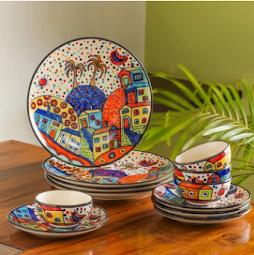
When was the last time you stopped to think about the
origin of that the cup of tea you are sipping from or the lovely ceramic plate
that you had your lunch on? COVID-19 has affected us all in different ways, but
it has also given me time to introspect on things such as the environment,
eating healthy, art and the resilience of human nature. One profound impact
this had on me was to try source products locally as much as possible and
encourage local artisans.
I have always felt that anything that you buy for your
home should have connection with you. Maybe, a childhood memory, designs
inspired from a series you like, a color or pattern that you can associate with
or something, that is so whimsical that it appeals to the child in you. And,
often, those patterns are closer home than you might think.
Pottery in particular has been dying a slow death in India due to lack of support from the general population and the government. Have you heard of Gujarat's Khavda whose origins date as far back as the Indus Valley civilization, or Nizamabad's Black Pottery which uses smoke fired with rice husks in enclosed kilns with the resulting soot giving the pottery its distinct shiny black surface? These regionalized techniques are just a few examples of the myriad pottery traditions that are prevalent across India, but are thoroughly underappreciated.
I have curated a series of cups, mugs and plates from ExclusiveLane which are made in collaboration with artists from all over the country. With intricate designs and vibrant hand-painted colors,these pieces are just exquisite. And whats more, each piece is unique because they are hand-made and has variations based on the artisan who worked on it. Check out these lovely collections.

Moroccan Blossoms:
Inspiration: Also known as Morocco's Blue City, Chefchaouen, situated in the North-West of Morocco in the Rif Mountains, was built as fortress in the 15th Century. Architecture enthusiasts will marvel at the Jewish-inspired blue-tinted buildings, octagonal mosques and Spanish ruins. Blue and White cobbled streets lined with vibrant pots with lush green plants and colorful flowers are another unmistakable feature of this city.
Dominant Color : Blue and White
Should Appeal To: Travelers, History Buffs, People
who love Blue
Symbolism: Blue is a calming color that symbolizes
stability, inspiration, wisdom and serenity. The floral patterns embedded in a hierarchical
structure represent the architecture and flowers of the blue city of Chefchaouen.

Banyan Marvels:
Inspiration: Situated around 25 kms from Bangalore, in the Ramohalli village, 'Dodda Alada Mara' (loosely translates to 'Big Banyan Tree') is a single Banyan tree that is spread over 3 acres of land and is more than 400 hundred years old. The Banyan (bargad) is a highly venerated tree in Hinduism due to its ability to survive and grow for centuries. This tree symbolizes the creator 'Brahma', as it represents longevity and eternal life. It is also called Kalpaka Vriksha or the wish full filling tree, in the Atharva Veda. It is also said that Lord Buddha gained his enlightenment under the Bodhi tree.
Dominant Color: Tea Green
Should Appeal To: People fascinated with Hindusim/Buddism, People who like green
Symbolism: The leaf of the banyan tree is said to be the resting place for Lord Krishna. The Banyan tree itself represents immortality and also symbolizes the Holy Trinity or Trimurti (Bark:Lord Vishnu, Roots:Lord Brahma, Branches:Lord Shiva). The color green also represents safety, harmony, freshness, growth and endurance.

The Hut Collection:
Inspiration: Depiction of a fishing village in Pondicherry. It is just another day in the village with the sun beating down on the rows of huts with triangular roofs and symmetrical windows, with the palm tree providing some respite from the heat. The markets are abuzz with vendors selling their fresh catch while the areas are lined with fish being dried to be made into pickles and dried fish.
Dominant Color: Multicolored
Should Appeal To: Those who like quirky things, appeals to your inner child
Symbolism: The vivid colors, the bold brushstrokes and the typical huts that we used to draw during our younger days remind us of the playfulness of our youth. It represents a time when things were simpler, and indeed the rustic nature of the art appeals to your inner child.
Please note that all products shown above are made in collaboration with artisans from all over India and are hand-painted with hand glazed studio pottery which is fired at 1200 degree Celsius. To know more, visit their website at ExclusiveLane or their Instagram page here.
About ExclusiveLane: ExclusiveLane was born out of a love of Indian Handicrafts in 2012 with the goal of bringing exclusive handicraft products to the urban consumer. By introducing and promoting these products in the domestic and international market, ExclusiveLane aims to uplift the economic condition of artisans who work hard to preserve the heritage of the Indian handicrafts industry.




